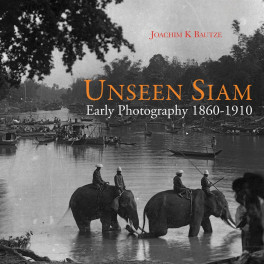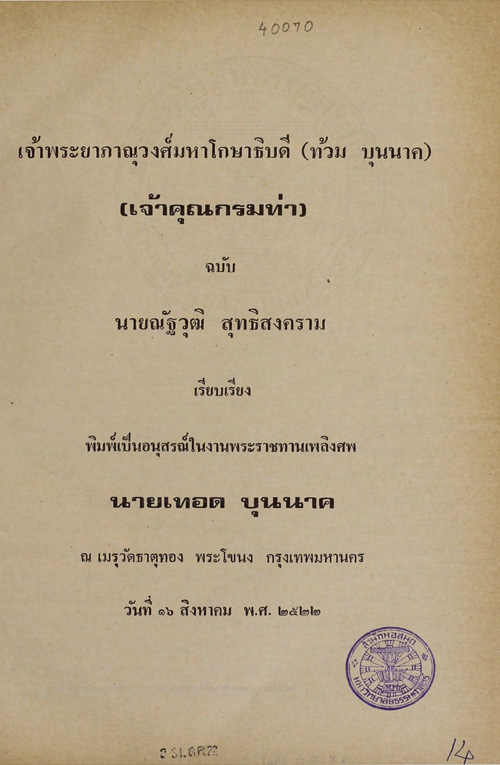
CHAO PRAYA BHANUWONGSE MAHAKOSA DHIBODI (TUAM BUNNAG)


The albumen photo of the Chao Praya mounted on card, signed at the back and dated 1877 whenhe was the Minister of Foreign Affairs of Siam. This particular photo was featured in the book "Unseen Siam - Early Photography 1860-1910" by Joachim K. Bautze, published in 2016, before it found its way to me that same year.

| Links: |
| เจ้าพระยาภาณุวงศ์มหาโกษาธิบดี |
| เจ้ากรมท่า จากหนังสืองานศพนายเทอด บุนนาค |
 |
Chao Praya Bhanuwongse Mahakosa Dhibodi was born in 1830 in the reign of King Rama III. His birth name was Tuam, and he was a son of the mighty Somdetch Chao Praya Borom Maha Prayurawongse (Dis) of the powerful Bunnag Clan. His elder brother was the all-powerful Somdetch Chao Praya Borom Maha Sri Suriyawongse, otherwise known as "The Sun" of the Bunnag family, who was Head of the Regency Council of King Chulalongkorn.
As I spent 11 years in the Ministry of Foreign Affairs, my interests in the history of Siamese diplomacy is one that is still close to my heart. Chao Praya Bhanuwongse was the very first Minister of Foreign Affairs of Siam. Although the diplomatic corp went back much farther, the old style foreign office was in fact part of the Finance department, and was known as "Krom Ta", Ta meaning 'port'. The Krom Ta was divided into 3 sections, which were Krom Ta Sai (The Left side) which dealt with businesses and diplomatic relations with China, Krom Ta Klang (The Middle) which was in charge with other foreign relations including the West, and Krom Ta Kwa (The Right side), which dealt with relations with East Asia and the Middle East, or the Muslim countries. Most of the officers in the Krom Ta Sai were of Chinese ancestry, while the officials of the Krom Ta Kwa were made up of decendants of East Asian heritage, with the Bunnag clan taking the lead as the family originated in Persia. Chao Praya Bhanuwongse was the Minister of Finance and Foreign Affairs during King Chulalongkorn's reign. The diplomatic office was officially separated from the Ministry of Finance and became the Ministry of Foreign Affairs on 14 April 1875.
During King Mongkut (Rama IV)'s reign, Chao Praya Bhanuwongse who held the title of "Jameun Rajamatya" then, was commanded by the king to accompany the delegation from Siam to England, to present presents to Queen Victoria. The delegation was headed by Praya Montri Suriyawongse (Chum Bunnag), his elder half brother. It was this experience that have given him that special knowledge that most Siamese did not have then, coupled with his wisdom and straightforwardness that King Chulalongkorn appreciated.

Siamese Delegation in audience with Queen Victoria

King Chulalongkorn visited India in 1871. Chao Praya Bhanuwongse is seated on the far right of the photo.
The Chao Praya in his capacity as Minister of Finance and Foreign Affairs, accompanied King Chulalongkorn on his first visits abroad, to India, Burma, Malaga and Penang between 16 December 1871 to 16 March 1872. The foreign office was later separated 3 years after, and the Chao Praya spent the next 10 years as Minister of Foreign Affairs until his retirement from illness as well as old age. King Chulalongkorn was sad to let Chao Praya Bhanuwongse retire, but asked him to stay as an advisor to the new Minister, his younger half-brother The Prince Devawongse Varopakarn who was only 27 years old at the time. He was a most trusted advisor for his tremendous experience and knowledge until his death on 13 May 1913 at the age of 83 years old, in the reign of King Vajiravudh (Rama VI). The King attended his bathing rites, which was and is still considered the highest honour.
Chao Praya had many wives per the custom then, and 25 children; 17 sons and 8 daughters. His oldest son was sent for education in England at the same time as my great-grandfather, Chao Praya Sri Pipat, again per the custom of royals and nobilities of the day. His descendants are numerous, as are the Bunnag clan today.

A young Tuam Bunnag


Another photos of the Chao Praya Bhanuwongse

The Chao Praya's eldest son, Sudjai, featured on the cover of the book "Siam Through the Lens of John Thomson 1865-1866".
 |
 |
 |
 |
 |
|
| Above is an original letter in French, and English translation, from Chao Praya Bhanuwongse to the representatives of the governments of France, Portugal and The Netherlands negotiating the importing law of liquors into Siam. The original letter signed by Chao Praya Bhanuwongse and sealed with his Minister of Foreign Affairs seal, in near perfect condition, considering they are nearly 150 years old! This is a very interesting find, as my family business is in alcoholic beverages, and this document is of the original discussion concerning the protection of Siam's liquor and alcoholic imports law. Funnily enough, the Siamese under the Kings sought to protect the domestically produced goods, though we did not produce beer back then, compared to the Siam under democratic rules after the 1932 Revolution forego a lot of these protections, of domestic businesses. Liquor and alcohols, as well as tobacco and opium, brought wealth to the Western colonisers, and these laws were pretty much the first to be negotiated when dealing with Western countries. | ||